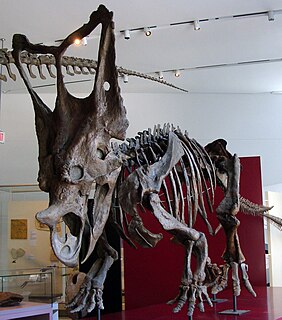
Chasmosaurus is a genus of ceratopsid dinosaur from the Upper Cretaceous Period of North America. Its name means 'opening lizard', referring to the large openings (fenestrae) in its frill. With a length of 4.3–4.8 metres (14.1–15.7 ft) and a weight of 1.5–2 tonnes, Chasmosaurus was a ceratopsian of average size. Like all ceratopsians, it was purely herbivorous. It was initially to be called Protorosaurus, but this name had been previously published for another animal. All specimens of Chasmosaurus were collected from the Dinosaur Park Formation of the Dinosaur Provincial Park of Alberta, Canada. Referred specimens of C. russelli come from the lower beds of the formation while C. belli comes from middle and upper beds.

Pentaceratops is a genus of herbivorous ceratopsid dinosaur from the late Cretaceous Period of what is now North America. Fossils of this animal were first discovered in 1921, but the genus was named in 1923 when its type species, Pentaceratops sternbergii, was described. Pentaceratops lived around 76–73 million years ago, its remains having been mostly found in the Kirtland Formation in the San Juan Basin in New Mexico. About a dozen skulls and skeletons have been uncovered, so anatomical understanding of Pentaceratops is fairly complete. One exceptionally large specimen later became its own genus, Titanoceratops, due to its more derived morphology, similarities to Triceratops, and lack of unique characteristics shared with Pentaceratops.

Styracosaurus is a genus of herbivorous ceratopsian dinosaur from the Cretaceous Period, about 75.5 to 75 million years ago. It had four to six long parietal spikes extending from its neck frill, a smaller jugal horn on each of its cheeks, and a single horn protruding from its nose, which may have been up to 60 centimeters long and 15 centimeters wide. The function or functions of the horns and frills have been debated for many years.

Pachyrhinosaurus is an extinct genus of centrosaurine ceratopsid dinosaur from the Late Cretaceous period of North America. The first examples were discovered by Charles M. Sternberg in Alberta, Canada, in 1946, and named in 1950. Over a dozen partial skulls and a large assortment of other fossils from various species have been found in Alberta and Alaska. A great number were not available for study until the 1980s, resulting in a relatively recent increase of interest in Pachyrhinosaurus.

Einiosaurus was a medium-sized herbivorous centrosaurine ceratopsian dinosaur from the Upper Cretaceous of northwestern Montana. The name means 'buffalo lizard', in a combination of Blackfeet Indian eini and Latinized Ancient Greek sauros; the specific name (procurvicornis) means 'with a forward-curving horn' in Latin.

Achelousaurus is a genus of centrosaurine ceratopsid dinosaur that lived during the Late Cretaceous Period of what is now North America, about 74.2 million years ago. The first fossils of Achelousaurus were collected in Montana in 1987, by a team led by Jack Horner, with more finds made in 1989. In 1994, Achelousaurus horneri was described and named by Scott D. Sampson; the generic name means "Achelous lizard", in reference to the Greek deity Achelous, and the specific name refers to Horner. The genus is known from a few specimens consisting mainly of skull material from individuals, ranging from juveniles to adults.

Centrosaurus is a genus of herbivorous ceratopsian dinosaurs from the Late Cretaceous of Canada. Their remains have been found in the Dinosaur Park Formation, dating from 76.5 to 75.5 million years ago.
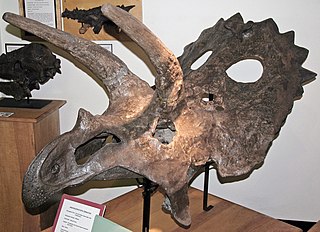
Anchiceratops is an extinct genus of chasmosaurine ceratopsid dinosaur that lived approximately 72 to 71 million years ago during the latter part of the Cretaceous Period in what is now Alberta, Canada. Anchiceratops was a medium-sized, heavily built, ground-dwelling, quadrupedal herbivore that could grow up to an estimated 5 m (16.4 ft) long. Its skull featured two long brow horns and a short horn on the nose. The skull frill was elongated and rectangular, its edges adorned by coarse triangular projections. About a dozen skulls of the genus have been found.
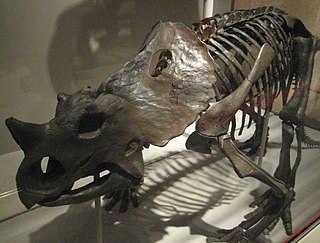
Brachyceratops is a dubious genus of ceratopsian dinosaur known only from partial juvenile specimens dating to the late Cretaceous Period of Montana, United States.
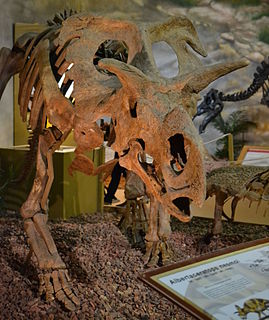
Medusaceratops is an extinct genus of centrosaurine ceratopsian dinosaur known from the Late Cretaceous Judith River Formation of Montana, northern United States. It contains a single species, Medusaceratops lokii.

Centrosaurinae is a subfamily of ceratopsid dinosaurs, a group of large quadrupedal ornithischians. Centrosaurine fossil remains are known primarily from the northern region of Laramidia but isolated taxa have been found in China and Utah as well.
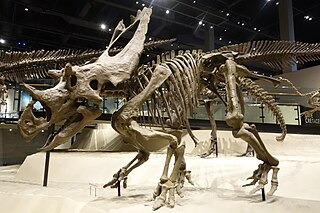
Utahceratops is an extinct genus of ceratopsian dinosaur that lived approximately 76.4~75.5 million years ago during the Late Cretaceous period in what is now Utah. Utahceratops was a large-sized, robustly-built, ground-dwelling, quadrupedal herbivore, that could grow up to an estimated 5–7 m (16–23 ft) long.
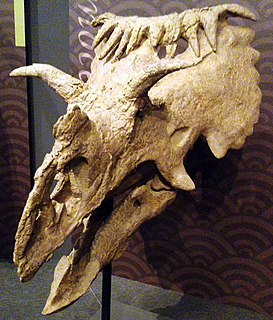
Kosmoceratops is a genus of ceratopsid dinosaur that lived in North America about 76–75.9 million years ago during the Late Cretaceous period. Specimens were discovered in Utah in the Kaiparowits Formation of the Grand Staircase-Escalante National Monument in 2006 and 2007, including an adult skull and postcranial skeleton and partial subadults. In 2010, the adult was made the holotype of the new genus and species Kosmoceratops richardsoni; the generic name means "ornate horned face", and the specific name honors Scott Richardson, who found the specimens. The find was part of a spate of ceratopsian discoveries in the early 21st century, and Kosmoceratops was considered significant due to its elaborate skull ornamentation.
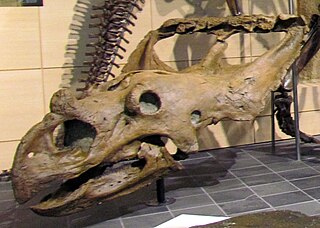
Vagaceratops is a genus of herbivorous ceratopsian dinosaur. It is a chasmosaurine ceratopsian which lived during the Late Cretaceous period in what is now Alberta. Its fossils have been recovered from the Upper Dinosaur Park Formation.

Nasutoceratops is an extinct genus of ceratopsian dinosaur. It is a basal centrosaurine which lived during the Late Cretaceous Period. Fossils have been found in southern Utah, United States. Nasutoceratops was a large, ground-dwelling, quadrupedal herbivore with a short snout and unique rounded horns above its eyes that have been likened to those of modern cattle. Extending almost to the tip of its snout, these horns are the longest of all the members of the centrosaurine subfamily. The presence of pneumatic elements in the nasal bones of Nasutoceratops are a unique trait and are unknown in any other ceratopsid. Nasutoceratops, Diabloceratops, and Machairoceratops are the only three centrosaurine dinosaurs from the American southwest.

Xenoceratops is a genus of centrosaurine ceratopsid dinosaur known from the Late Cretaceous, and is known to have lived in what is currently Alberta, Canada. The genus has one known species, Xenoceratops foremostensis. Its remains were discovered in the Foremost Formation.

Coronosaurus is a genus of centrosaurine ceratopsian dinosaurs which lived in the Late Cretaceous, in the middle Campanian stage. Its remains, two bone beds, were discovered by Phillip J. Currie in the Oldman Formation of Alberta, Canada, and its type and only species, Coronosaurus brinkmani, was first described in 2005, as a new species within the genus Centrosaurus. Later studies questioned the presence of a direct relationship, and in 2012 it was named as a separate genus. Coronosaurus means "crowned lizard", coming from "corona", Latin for crown, and "sauros", Greek for lizard; this name refers to the unique, crown-like shape of the horns on the top of its frill.

This timeline of ceratopsian research is a chronological listing of events in the history of paleontology focused on the ceratopsians, a group of herbivorous marginocephalian dinosaurs that evolved parrot-like beaks, bony frills, and, later, spectacular horns. The first scientifically documented ceratopsian fossils were described by Edward Drinker Cope starting in the 1870s; however, the remains were poorly preserved and their true nature was not recognized. Over the next several decades, Cope named several such genera and species. Cope's hated rival, Othniel Charles Marsh, also described ceratopsian remains. In 1887, Marsh mistook a Triceratops horn for one belonging to a new species of prehistoric Bison. Marsh also named the eponymous genus Ceratops in 1888. The next year, he named the most famous ceratopsian, Triceratops horridus. It was the discovery of Triceratops that illuminated the ceratopsian body plan, and he formally named the Ceratopsia in 1890.

Machairoceratops is an extinct genus of centrosaurine ceratopsian dinosaur known from the Late Cretaceous Wahweap Formation of Grand Staircase-Escalante National Monument, southern Utah, United States.

Yehuecauhceratops is a genus of horned centrosaurine ceratopsid dinosaur from the Late Cretaceous of Coahuila, Mexico. It contains a single species, Y. mudei, described from two partial specimens by Rivera-Sylva et al. in 2016 and formally named by Rivera-Sylva et al. in 2017. It was a small centrosaurine with a body length of 3 metres (9.8 ft), making it smaller than Agujaceratops and Coahuilaceratops, the other two ceratopsids in its environment; the three may have been ecologically segregated. A ridge bearing a single roughened projection near the bottom of the squamosal bone, which probably supported a small horn, allows Yehuecauhceratops to be distinguished from other centrosaurines. Its affinities to nasutoceratopsin centrosaurines, such as Avaceratops and Nasutoceratops, are supported by various morphological similarities to the former.




























